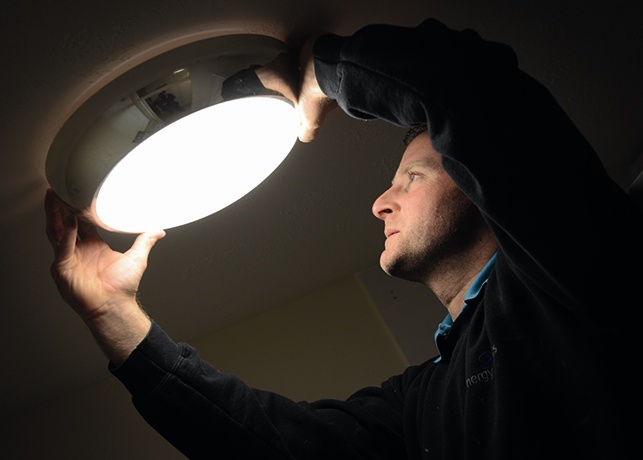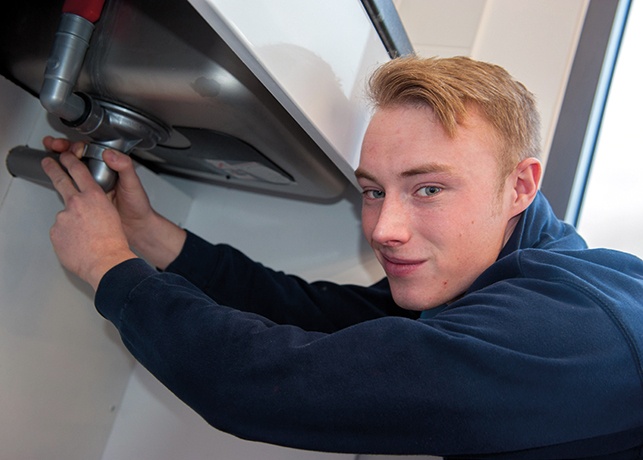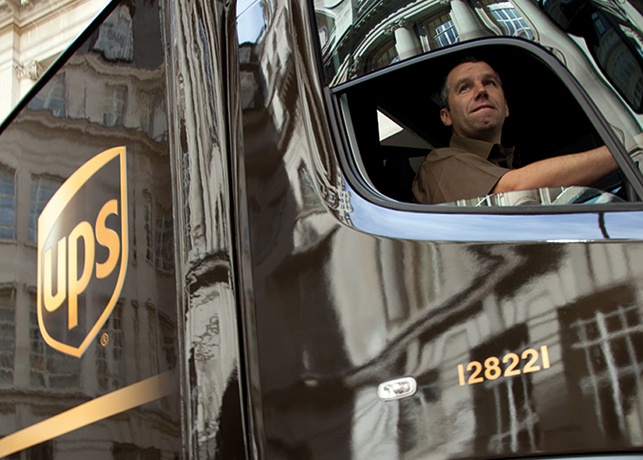Installing bright ideas
Meet one landlord inspired by good practice from the commercial sector and one of the firms it visited to hone its business model

A light bulb is installed in an Aster Group home
Article written in partnership with:

Aster Group
Number of operatives: 310
Number of homes served: 28,000
Savings on repairs made in 2015: £500,000
Repairs are a major undertaking for every housing provider, and that is certainly the case for Aster Group. Its asset management and maintenance is a £55m turnover operation, with 310 operatives spread across the South West, from Wiltshire, Hampshire and down to Cornwall.
Aster Group began a business-wide efficiency drive in early 2015, pinpointing areas in which savings could be made and then diverted into building homes. “That’s a key driver for us,” says operations director Alec Pegram. “To achieve our vision that everyone has a home, we have to be more efficient.”
The 1% rent cut that the government imposed on the sector in last July’s Budget statement translates into a 14% cut to Aster Group’s business plan over four years, which as Mr Pegram says is “quite a big hit”.
The landlord’s efficiency drive saw his division, which employs 93 operatives on responsive repairs and voids, challenged to make £350,000-worth of savings last year. In fact, it achieved £500,000, making a number of changes following extensive consultation with tenants.
“Some of this is about reducing the nice-to-haves,” explains Mr Pegram. It has cut back on unnecessary decoration of void properties and asks more questions before attending to emergency repairs. He adds: “We were probably going out more often than we needed to. Someone might call up and say they’ve had a heating failure, and then we go out and find it is just one radiator. We are far more inquisitive now, so we are only going out to real emergencies.”

Aster Group staff work on a boiler
It has seen a dramatic reduction in the costs associated with voids, partly caused by avoiding the need to repair them in the first place. Mr Pegram explains: “We carry out inspections before the end of a tenancy, identify anything that needs to be put right and give customers a chance to do it. That’s reducing void costs, and we’re beginning to see an improvement in turnaround times too.”
Mr Pegram jumped at the opportunity to take part in HouseMark’s business transformation project focusing on the use of in-house direct service organisations (DSOs) to provide repairs. He has since visited a range of organisations that run comparable services, including BT, Autoglass, Scottish Water and UPS, as well as Wakefield District Housing and Herefordshire Housing.
“Seeing that diversity was fascinating,” says Mr Pegram. “It gave me the wider perspective on performance, such as the need to have a strong culture, strong leadership and agility.
“The best commercial organisations are really forward-thinking and have a fail-fast mentality - they face similar challenges to housing, but they move a lot quicker. There was also a consensus that our sector was behind in terms of IT, particularly around workflow.”
Mr Pegram was inspired by many small snippets of good practice from the visits, which he will try to apply in his own role. Travel is estimated to account for up to 70% of the cost of a job, so this remains a top priority. “Why can’t we set a 10% reduction target and challenge the business to find savings?” he asks. “Scottish Water did this and achieved it.”
Mr Pegram was also intrigued to find out that 80 of Autoglass’ 340 call centre staff work from home - particularly as Aster Group is about to review its call centres, to introduce flexible working, and wants to better use digital technology. “The visits provided much more than an insight into operational delivery,” he says. “I have shared as much information with my housing colleagues as with maintenance.”

A UPS van driver
UPS
UK employees: Approximately 8,000
Training for new drivers: 40-plus hours in the classroom, 22-plus days on the road
Fastest time from taking an order to despatching it: 30 minutes
It may be a $60bn business with 444,000 employees in more than 220 countries, but logistics giant UPS has the equivalent of a direct services organisation (DSO) at its heart, says Derek Irving, UK director of contract logistics, referring to the in-house labour forces employed by many social landlords to maintain their homes.
“We essentially have a DSO getting inventory to where it’s required, by the time it’s required,” he says. “The scale is different, but there are fundamentally similar methodologies.”
This is why UPS was a recent destination for participants in HouseMark’s DSO project, which saw housing professionals visit a range of commercial organisations to see how they dealt with the challenges of a roving workforce. As well as the familiar parcel delivery service, UPS transports freight by ground, sea and air - it is the world’s ninth-largest airline - operates an after-sales parts distribution service, and a specialist service for the healthcare sector. It also makes about 1,200 deliveries every night through its ‘in-boot’ service for companies such as Vaillant Group, where all of the components that an engineer will need for the next day are placed directly into their van while they sleep.

A UPS warehouse
Logistics is highly competitive, as new entrants have driven down margins and the need for speed and accuracy must be constantly balanced against keeping costs low. The rise of internet shopping over the past decade means delivering many smaller packages to consumers, rather than bulk shipments to stores, and introducing a fast-flowing stream of traffic in the opposite direction in the form of returns. “The e-tailer is already refunding the cost of the goods so they want to get them back as cheaply as possible,” says Mr Irving. “But they also want them back as quickly as possible so they can resell them.”
The secret of UPS’s success is a relentless focus on efficiency, and every aspect of the service has been studied and optimised. “We are engineers by trade,” explains Mr Irving. “Making a tradesperson more productive means engineering out everything that’s non-productive. When you look at the way a UPS driver makes a delivery, everything is as efficient as we can possibly make it - right down to the way he takes off his seat belt and how he opens the door. We measure everything to the nth degree.”
For a social landlord’s repairs service, this could mean eliminating trips to builders’ merchants or time spent in central warehouses, he suggests, adding that UPS is hoping to pilot its in-boot service with a social housing provider.
UPS applies the same approach to its call centres so that enquires are resolved at the first time of asking - it has analysed peak demand and concentrates resources appropriately. And it uses technology to reduce wasted visits, offering consumers the chance to book deliveries at convenient times through its website or app. As Mr Irving says: “What we don’t want to do is be knocking on doors unnecessarily if no one’s in.” A sentiment that will be all too familiar to those involved in housing repairs.







